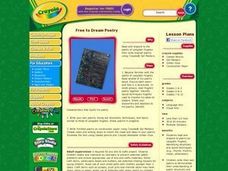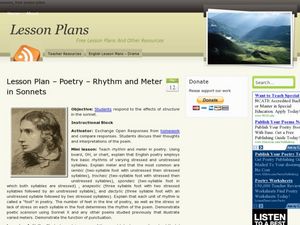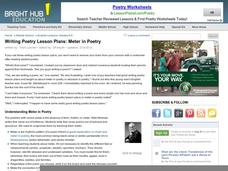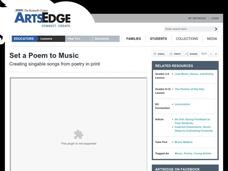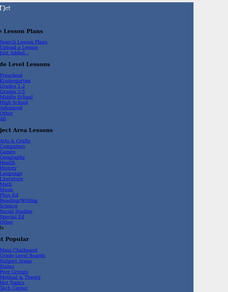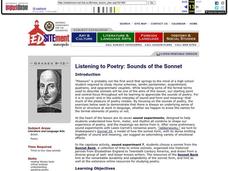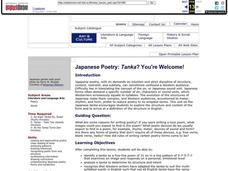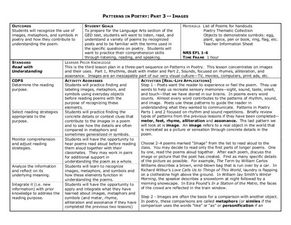Curated OER
Free To Dream Poetry
Learners explore the poetry of Langston Hughes and its structure. In groups, they read poems and identify the rhyme, rhythm meter, and alliteration in each poem. Students create and illustrate their own poem, using Langston Hughes methods.
EBSCO Industries
Music and Poetry
Song lyrics, like poems, are meant to be heard. After examining the literary devices in several poems, scholars examine the lyrics of popular songs and identify the sound devices and the figurative language writers use to create the...
Curated OER
Set a Poem to Music
Fun awaits both you and your class as you embark on a musical activity. After discussing different rhythmic meters they choose a poem to set to music. The poem must rhyme and be set to a melody in the key of C Major. Because the activity...
Curated OER
Japanese Poetry: Tanka? You're Welcome!
Students explore tanka, a form of Japanese poetry. They read and analyze tankas to determine the structure and intent, and compose a traditional and a non-traditional tanka.
Curated OER
Poetry--Rhythm and Meter in Sonnets
Students identify rhyme scheme and meter in a poem and respond to the message of the poem. In this sonnet rhythm and meter lesson, students take notes on a lecture about rhythm and meter in sonnets and work in small groups to read...
Curated OER
Meter in Poetry
A good poem has form and structure built into it. Middle schoolers see that the structure of a poem consists of stanza, form, rhyme, and meter. The structure also contributes to a poem's meaning. After listening to, and discussing, a few...
Curated OER
Edward Lear, Limericks, and Nonsense
Introduce your class to the delights of nonsense poetry and explore literary devices with the writing of Edward Lear. Learners identify rhyme and meter as well as figures of speech, alliteration, and onomatopoeia in "The Owl and the...
Prestwick House
"Because I could not stop for Death" -- Visualizing Meaning and Tone
Emily Dickinson's "Because I could not stop for Death" provides high schoolers with an opportunity to practice their critical thinking skills. They examine the images, diction, rhythm, and rhyme scheme the poet uses and consider how...
Curated OER
Personal Poetry Books
Students work in the classroom and in the computer lab to produce a Personal Poetry Book.
EngageNY
Author’s Craft: The Poetry of the Play
Feel the rhythm! Pupils begin reading Act 2, Scene 1 of Shakespeare's A Midsummer Night's Dream as they continue participating in a drama circle. With discussion, they examine Shakespeare's use of rhyme, rhythm, and meter, analyzing how...
Curated OER
Set a Poem to Music
Young scholars consider the role of rhythm and meter in poetry. In this integrated arts activity, students discuss the attributes of poetry and use their music skills to set picture book poetry to music by creating "singable" poems.
Curated OER
Poems That Work!
Students are introduced to the elements of poetry. As a class, they practice the correct way to read a poem and determine the author's audience. They identify similies and metaphors and determine the rhyme and meter. To end the...
Curated OER
Edward Lear, Limericks, and Nonsense: There Once Was...
Learners recognize poetic devices including rhyme, syllabification, and meter. They identify the characteristics of a nonsense poem and of a limerick. They write their own limericks.
Curated OER
Analysis of Frost's poem The Road Not Taken
Students read and analyze the Robert Frost poem, "The Road Not Taken." They identify the meter and rhyme, describe the purpose, and write a paragraph about what kind of job they plan to have and why they have chosen it
Curated OER
Quirky Quatrain Poetry Lesson
Middle schoolers discover what a quatrain is, and are taught the three poetic devices: alliteration, hyperbole, and onomatopoeia. Everyone chooses a favorite hobby or activity, then attempts to write a poem about it. They must write two...
Curated OER
Listening to Poetry: Sounds of the Sonnet
Students experience and enjoy the sounds of poetry. They erform sound experiments with sonnets and closely read and analyze a sonnet by Shakespeare. Students write an analysis of how sound affects meaning in a sonnet chosen from the...
Curated OER
The Poetics of Hip Hop
The Bard, Nikki Giovanni, Mos Def? “Sonnet 18,” Ego Tripping,” and “Black on Both Sides”? Sure! It’s the poetics. Class members compare the lyrics, rhythm, and rhyme in classic poetry to hip-hop in a richly detailed resource that...
Curated OER
Japanese Poetry: Tanka? You're Welcome!
Students explore the structure and content of the Tanka form and to arrive at a definition of the structure in English. They analyze a tanka to determine its structure and intent and compose two Tanka; one in traditional form and one...
Curated OER
The Sounds of Daydream
Based on the poem "The Lake Isle of Innisfree" by Irish poet William Butler Yeats, this resource is well constructed and guides learners through examining the Yeats poem (rhyme, meter, content) to composing a poem of their own about a...
Curated OER
Patterns In Poetry: Images (Part 3)
High schoolers explore imagery in poetry. In this poetry lesson, students examine how the use of metaphors and similes aid in reading comprehension. Multiple resources are provided.
Curated OER
Ode to the Earth: Magnetic Poetry
Students explore Earth Day by creating an arts and crafts project. In this nature appreciation lesson plan, students utilize nature related vocabulary terms on magnets and put them in different orders to create interesting poetry....
Curated OER
Edward Lear, Limericks, and Nonsense: There Once Was?
Students explore limericks. For this poetry writing lesson, students listen to and read a variety of poems written by Edward Lear. Students count syllables and identify meter by clapping as they read aloud. Students complete a...
Curated OER
This Isn't Your Little Sister's Poetry: Analyzing and Understanding a Variety of Acclaimed Poets
Eleventh graders are introduced to various basic and advanced poetic devices. They read several poems and practice identifying poetic elements. They identify at least two different poems and substantiate why they belong in the canon.
Curated OER
The Whale Poem
Learners watch a whale video clip for information. Students brainstorm on the facts that they learned about whales. Learners use the Internet to find information and images about whales. Students write and publish a whale poem.
